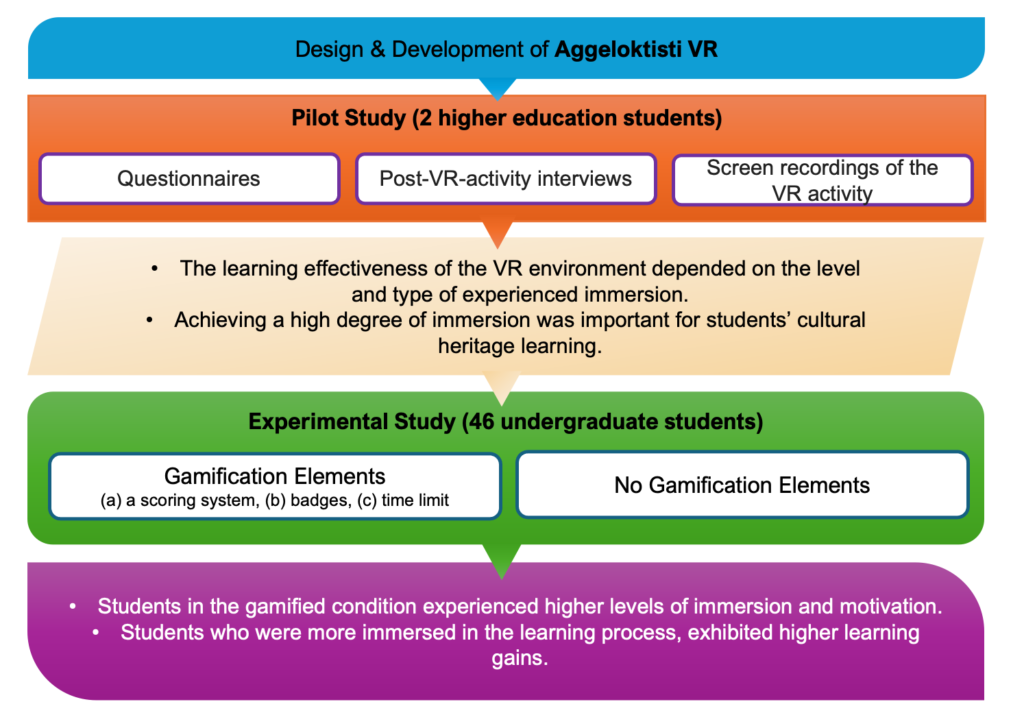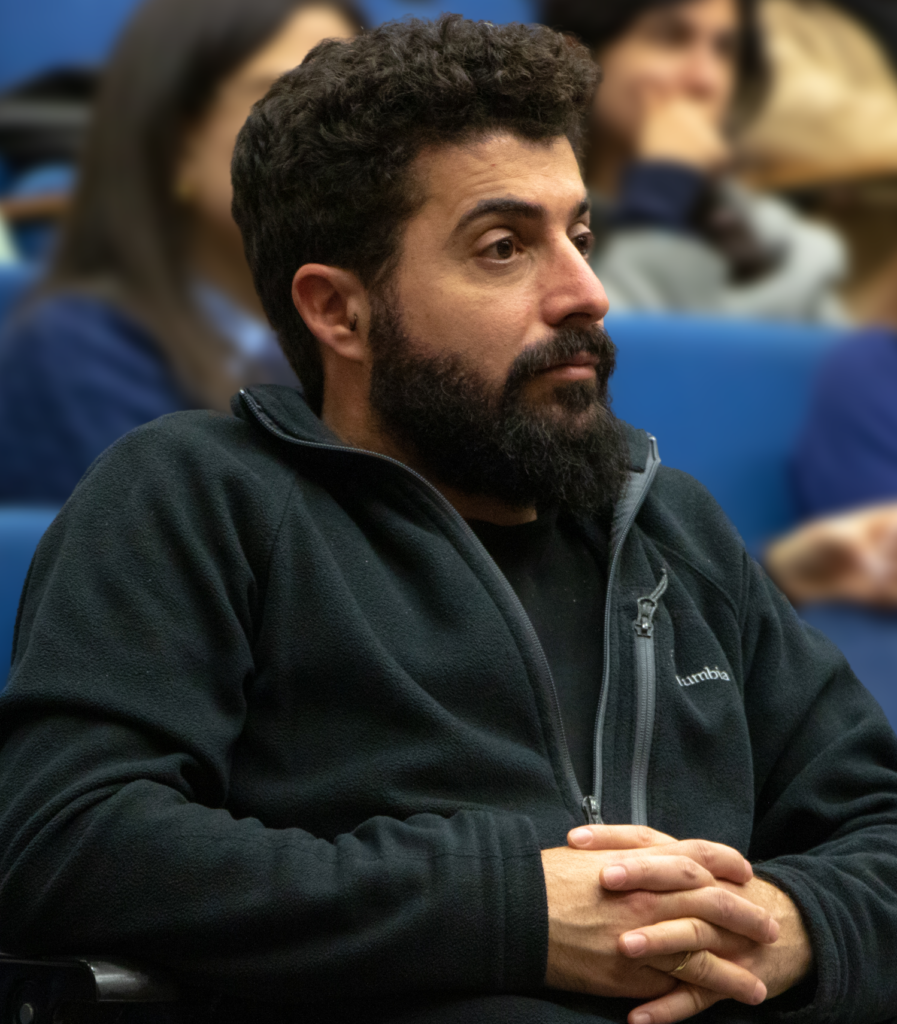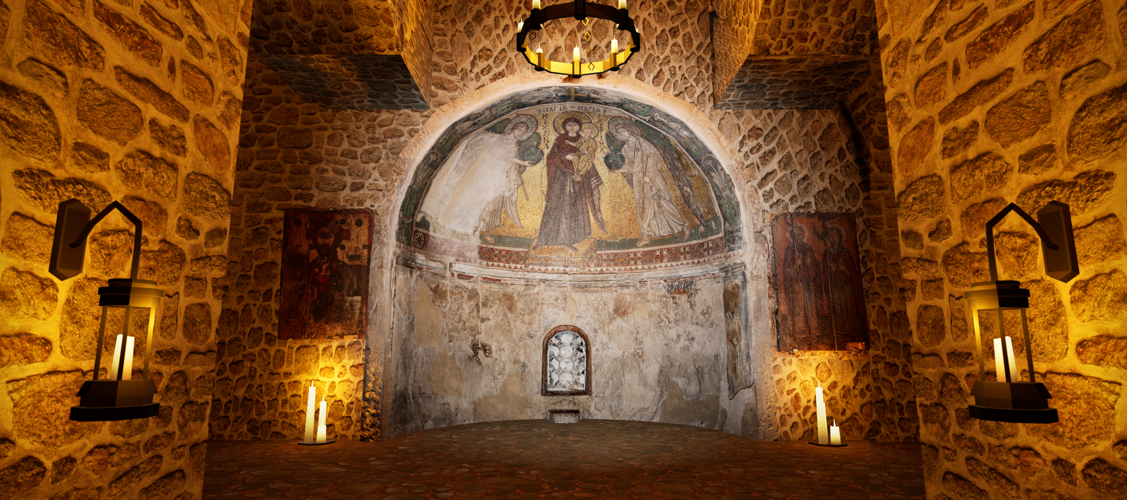by Markos Souropetsis, Eleni A. Kyza, Louis Nisiotis & Yiannis Georgiou.
Fun and playfulness are probably not the first terms that come to mind when thinking about history education and cultural heritage learning. For example, students often take part in various school trips to local archaeological and cultural heritage sites. However, in many cases, these field trips fail to capture students’ interest, as students play the role of passive listeners to tour guides who share fragments of historical knowledge, adopting a teacher-centered approach. To tackle these challenges, in the Aggeloktisti VR project we set out to design more engaging cultural heritage learning experiences by leveraging the potential of immersive Virtual Reality (VR).
The Aggeloktisti VR environment
The Aggeloktisti VR learning environment was designed to help higher education students learn about the history and cultural heritage of the Aggeloktisti Byzantine church in Cyprus, and in particular, a prominent ceiling mosaic that dates to the 6th century AD. The VR learning environment provides a 3D simulation of the interior of the church and the VR activity is structured around an inquiry-based learning scenario (picture below). The learning mission requires students to adopt the role of historians who visit four areas (learning stations) in the church, collect and synthesize evidence and complete a quiz at each learning station, before “unlocking”, and proceeding to, the next learning station. Each learning station features different educational materials in various multimedia formats (e.g., videos, figures, and diagrams), providing information regarding the historical significance of the mosaic and supporting students to reach an evidence-based conclusion about the dating of a church ceiling. To experience the VR world, each student uses a head mounted VR display, and experiences the environment through a single-user mode.

Potential to support immersive learning
Findings from a pilot study with two higher education students indicated that the VR environment shows great potential for providing immersive experiences that support cultural heritage learning among university students. However, we also found that the learning effectiveness of the VR environment largely depended on the level and type of immersion experienced by the users. Achieving a high degree of immersion was important for students’ cultural heritage learning. However, simply reaching a high level of presence in the VR environment was not sufficient for meeting the underpinning learning goals. It was equally important for the students to engage deeply with the inquiry-based activities embedded in the VR environment.
Let’s gamify it
Based on the pilot study results, we focused our design efforts on how to provide a more beneficial immersive learning experiences in this VR setting. To achieve this objective, we decided to leverage the affordances of gamification to make learning more attractive and, hopefully, more effective for the university students. To do so, we gamified the VR learning environment integrating three main elements designed to support students’ motivation to learn. Specifically, the gamified VR learning environment included: (a) a scoring system, as students earned points by correctly responding to a multiple-choice quiz at each learning station, (b) badges, as students received a badge each time they completed a task at each learning station, and (c) a time limit of 30 minutes to complete the inquiry; when the time limit expired, the learning environment locked and students could no further interact with it.
The power of gamification
Next, we investigated the effect of gamification on university students’ immersion, motivation and cultural heritage learning. Our hypothesis was that gamification may contribute to students’ immersion by making learning more engaging. An experimental research design was adopted to analyze the experience of 46 undergraduate students who were assigned to one of two conditions (Gamified/Non-gamified VR environment). Findings indicated that students in the gamified condition experienced higher levels of immersion and motivation. More specifically, the gamified elements were effective in directing students’ focus toward the inquiry-based learning activities embedded within the VR environment. In turn, students who were more immersed in the learning process, also exhibited higher learning gains. An overview of the study is presented below.

Take away messages
The findings of this study can inform the principled design of immersive VR environments to optimise students’ knowledge acquisition. Adopting an edutainment approach, and leveraging the affordances of gamification, our study underpins the role of fun and playfulness for supporting students’ immersion, motivation, and cultural heritage learning in immersive VR environments.
Acknowledgements
The authors would like to thank Pavel Telnov and Pascal Schovanez from UCLan Cyprus for their contribution to the development of the VR environment, and Varnavia Giorgalla and Maria Efpraxia from the Cyprus University of Technology for their support during data collection. We would also like to thank the students of the Cyprus University of Technology for their participation in this study.
Authors

Markos Souropetsis, Cyprus University of Technology, Limassol, Cyprus

Eleni A. Kyza, Cyprus University of Technology, Limassol, Cyprus

Louis Nisiotis, University of Central Lancashire, Cyprus Campus, Larnaka, Cyprus

Yiannis Georgiou, Cyprus University of Technology, Limassol, Cyprus














